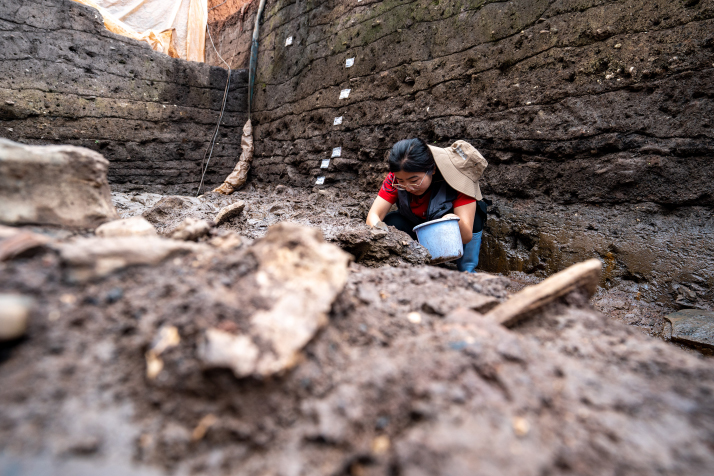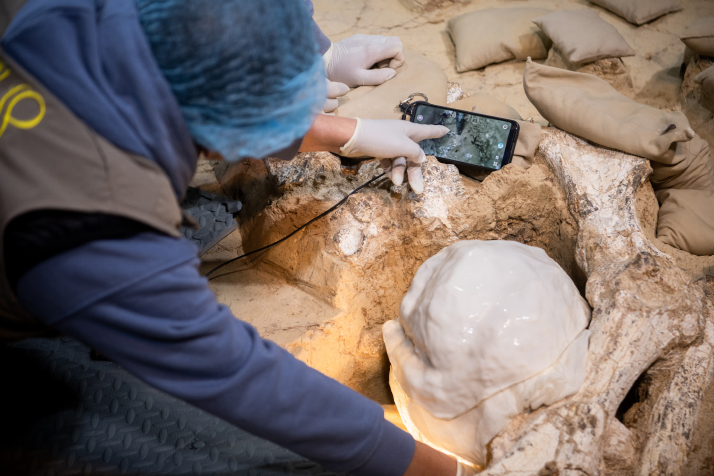| China |
| New skull sheds light on human origins | |
|
|
 An archaeologist works at the Hebosuo relics site in Yunnan Province on September 21, 2022 (XINHUA)
China's ancient skull fossil trove got a new member after a 1-million-year-old skull was unearthed in Hubei Province on December 3, 2022. The newly discovered skull is thought to be the most intact Homo erectus skull of its age found on the Eurasian continent to date.
Dubbed the "No.3 Skull of Yunxian Man," it was found at the Xuetangliangzi site, an early Paleolithic site in Yunyang District of Shiyan City. In 1989 and 1990, two other skulls were excavated there, about 35 meters away from this newly discovered fossil. Those two were later determined to be 800,000 and 1.1 million years old. At the time, Yunyang was a county named Yunxian and the two skulls were thus named the No.1 and No.2 Skull of Yunxian Man.  An archaeologist excavates the No.3 Skull of Yunxian Man in Shiyan, Hubei Province, on December 3, 2022 (XINHUA)
The cluster The skull was first found in May 2022 but took over six months to unearth. The archaeological team worked in an area of 4 square meters and removed surrounding layers of soil bit by bit. Gao Xing, a researcher at the Institute of Vertebrate Paleontology and Paleoanthropology under the Chinese Academy of Sciences compared the digging process to a long and delicate surgery. "The goal was not simply to dig out the skull," Gao said. "Samples of soil and ancient animal fossils along with stone tools surrounding the skull have all been carefully removed and stored. This slowed down the extraction process." "We divided the 4-square-meter area into four sub-areas and removed 2-cm layers of soil from the areas one at a time," Lu Chengqiu, Director of the excavation project, told Hubei Daily. "We took over 10,000 high-definition photos of each layer." The photos were then uploaded to DasEarth, a three-dimensional (3D) modeling platform developed by Wuhan University for real-time processing. Over the six-month process, the team filmed the excavation, extracted more than 1,400 sedimentary samples and took over 200,000 photos. Based on the photos, they then created more than 20 3D models, laying a foundation for the fine digital recreation of the burial environment of the skull and related research. A temporary archaeological lab of over 1,000 square meters was set up on the site, the temperature and humidity of which have been monitored constantly to ensure the preservation of the ancient artifacts found there. This skull and the previous two found at the site were determined to be specimens of Homo erectus, who lived on the earth 300,000 to 1.8 million years ago as a predecessor of Homo sapiens. The two previously discovered skulls, now on display at the Hubei Provincial Museum, are not as intact and well-preserved as the newly unearthed one. Unlike those on the previous two, the frontal bone and eye sockets of the No.3 show no obvious damage. Gao said the No.3 Skull is expected to provide important evidence on the evolution of the Homo erectus and its origin and development in East Asia, as the time that they lived is a key point in the evolution of Homo erectus. Over recent decades, Chinese archaeologists have discovered more than 60 ancient human fossil sites and more than 1,000 Paleolithic cultural sites. The most renowned of these include Peking Man, who lived 700,000 to 200,000 years ago and who was discovered on the outskirts of Beijing in the 1920s, and Yuanmou Man, also known as Homo erectus yuanmouensis, who was found in Yunnan Province. The skull of Yuanmou Man dated back over 1.7 million years, making it the oldest skull fossil ever found in China. Stone tools and some animal fossils have also been found along with these skulls. At the No.3 site, a large number of stone tools and multiple fossils of herbivorous animals, including elephants, horses and cattle, were found, indicating Yunxian Man was able to make and use tools to hunt for food. Experts will conduct further research on the skull at the Beijing-based Institute of Vertebrate Paleontology and Paleoanthropology to get a more complete picture of the person's age, gender and lifestyle. A bigger picture The excavation of this skull is one of the achievements of the fifth stage of a national research program dedicated to tracing the origin of Chinese civilization. The program covers over 200 archaeological excavation projects, including the Sanxingdui Ruins in Sichuan Province, where quite a few wellknown discoveries have been made in recent years. Other major discoveries of the program include the Hebosuo relics site in Yunnan Province, where a great number of bamboo scripts and official seals dating back to the Han Dynasty (202 B.C.- A.D. 220) were found as evidence of the interaction and fusion of diverse ethnic groups in ancient China. At a ruin site of a bridge built during the Tang Dynasty (618-907) in Henan Province, roughly 60,000 cultural relics have been discovered which provide insight into the cultural evolution of the Grand Canal, the world's longest man-made waterway. Chen Xingcan, head of the Institute of Archaeology under Chinese Academy of Social Sciences, emphasized the importance of advanced technologies in making these findings, while announcing the archaeological achievements at a press conference on September 28, 2022. Chen said that by using modern scientific techniques and technologies such as laser scanning and 3D reconstruction, experts have been able to gain greater insights into relics. "Archaeological institutes throughout China have continued to develop new technologies for confirming the ages of relics and researching the natural environment in ancient times," Chen added. (Print Edition Title: An Ancient Ancestor) Copyedited by G.P. Wilson Comments to yuanyuan@cicgamericas.com |
|
||||||||||||||||||||||||||||||
|
